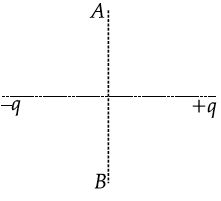A charge ‘q’ is moved from a point A above a dipole of dipole moment ‘p’ to a point B below the dipole in equatorial plane without acceleration. Find the work done in the process.
No work is done.
W = q = q × 0 = 0
Detailed Answer :

It is seen that potential due to dipole at any point on equatorial line in equatorial plane is zero. From the figure, points A & B lies in equatorial plane of dipole, where work done in moving charge 'q' from point A to B without acceleration will be zero.
W = q = q × 0 = 0
Detailed Answer :

It is seen that potential due to dipole at any point on equatorial line in equatorial plane is zero. From the figure, points A & B lies in equatorial plane of dipole, where work done in moving charge 'q' from point A to B without acceleration will be zero.
Derive an expression for potential due to a dipole for distances large compared to the size of the dipole. How is the potential due to dipole different from that due to single charge ?
Draw a plot showing the variation of (i) electric field (E) and (ii) electric potential (V) with distance r due to a point charge Q.
What is the amount of work done in moving a point charge around a circular arc of radius r at the center where another point charge is located ?
An electron is accelerated through a potential difference V. Write the expression for its final speed, if it was initially at rest.
Obtain the expression for the potential due to an electric dipole of dipole moment p at a point ‘d’ on the axial line.
Why are electric field lines perpendicular at a point on an equipotential surface of a conductor ?
Two point charges q and –2q are kept d distance apart. Find the location of the point relative to charge q at which potential due to this system of charges is zero.
Why do the electrostatic field lines not form closed loops ?
Why are electric field lines perpendicular at a point on an equipotential surface of a conductor ?
In a series LR circuit = R and power factor of the circuit is P₁. When capacitor with capacitance C such that = is put in series, the power factor becomes P₂. Calculate P₁ / P₂.
Graph showing the variation of current versus voltage for a material GaAs is shown in the figure, identify the region of :
A capacitor of 4 μF is connected as shown in the circuit Figure. The internal resistance of the battery is 0.5 Ω. The amount of charge on the capacitor plates will be :
A point charge +Q is placed in the vicinity of a conducting surface. Draw the electric field lines between the surface and the charge.
